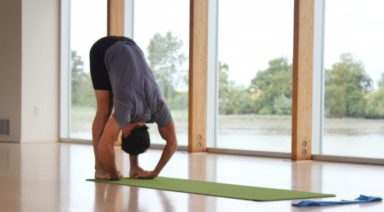3 Ways to Use Yin Yoga For Release

Learning to let go has become a life task for most people, including myself.
Although I have several certificates saying that I am a yoga teacher, this does not mean that I have also mastered all the difficulties which come across in life. I have been a yoga practitioner for many years and every time I think I’ve learned something about the ability to let go, something else comes up and shows me how much I still have to learn.
It sounds so simple, yet it is so hard to do. We hold onto our fears, our anger and sorrow without realizing that, by doing this, we are losing our ease in life. Practicing Yin Yoga was a great help to me when it came to learning how to let go more easily.
Let Go in Your Body
When you enter into a Yin Yoga pose you have to let go on a physical level. It is not a good idea to keep the muscles in the pose active over a period of several minutes because it will only make you feel more tension. In a Yin pose you are asked to passively sink into it as much as your body will allow.
Let Go in Your Breath
Once you’ve learned to relax your body, you will notice your breath flowing effortlessly with more and more ease and tranquility. You don’t have to think about your breath flow anymore, so just let it come and go without directing it.
Let Go in Your Mind
This will eventually lead to stillness of the mind. When you start diving into your own silence you begin to realize what you are clinging on to: all the unnecessary worries of the past and the anxieties about the future. Maybe you’ll feel that you are tensing up again in your body as these thoughts arise. As you remember to sink deeper into your Yin pose, and let the tensions in your body go by connecting to your breath, you will be able to let these thoughts go as well.
Coming out of a Yin pose, and shifting back to neutral in your body, will leave you with a feeling of lightness and ease. Once you realize how good it feels to let go of the things that don’t serve you in life, you will probably want to practice it more often. Practice Yin Yoga and start experiencing the happiness you really deserve.
Yin Yoga Benefits and History

Maybe you’ve heard of yin yoga but don’t really know what it is. Maybe you’ve tried it but lack some understanding of its origin or purpose. Or perhaps this is the first you’re hearing of it.
This exploration of the benefits and history of yin yoga will provide you some understanding of where yin came from and how it benefits people. If you find it compelling, get on your mat, keep learning more, and let us know how your journey unfolds.
To prepare for this article, I interviewed several Boston-based yin yoga teachers and regular practitioners. This is their scoop, filtered through some of my own experiences on what the benefits of this slow, meditative practice are.
What are the Benefits of Yin Yoga?
Seeing Within
When practicing this turtle-paced yoga style, unlike other varieties that are fast-moving and fancy looking, there is no wow-factor for spectators. Because yin yoga stretches connective tissue, especially at the joints, difficult inversions and impressive poses wouldn’t be safe considering how long they are to be held (anywhere from a couple of minutes up to around 20 minutes). To experience the wonders of yin, practitioners simply hold well-aligned, basic poses.
Doing poses in stillness promotes the cultivation of the inner life.
As yin yoga enthusiast Kourtney Hartmoyer has so eloquently put it, “the shapes are simple, perhaps even boring. To the outside world, it doesn’t look too interesting. However dull from an outside view, what I have found is that the quiet stillness of yin allows me to better observe the inner self a bit more clearly. It magnifies everything. That is where I find the magic.”
I have felt the magic, too. Yin yoga helps me to see myself on a deeper level through the cultivation of stillness. When I practice it’s not always easy or even possible to become physically still. Yet when I am able to “drop-in” and become motionless, the depth of awareness is simultaneously awe-inspiring and intrinsically peaceful. I can watch the inner play of my mind and subtle body as an observer. I can see within.
If you are planning to start a yin practice, it’s okay not to be absolutely still. It’s okay to struggle. The struggle contains information you can observe with kindness and curiosity. And when it finally subsides and you can be still, you can move deeper into yourself and into greater states of euphoric relaxation.
Moving Into Deeper States of Relaxation
Joanna Barrett told me that her daily yin practice helps her “to sit with sensation, moving toward or into deeper states of relaxation.” Moving quickly cannot promote deep trance-like states in the manner utter stillness can. If you’re curious, swap out the vinyasa flow for a yin vibe to appreciate what Joanna is talking about.
The depths of relaxation may require some preparation and commitment of time. It wouldn’t make sense for you to rush into a meditative state.
You’ll need time to allow your body to slowly drop into the depths of each pose. Completely support yourself with props, breathing deeply with lungs that move air like the bellows that feed fire.
Sure enough, the depth of sensation will tempt you to get out of the pose. I urge you to remain still while breathing deeper to experience the peace and meditation of true surrender. Can you stay just a little longer and relax just a little more? That might require a great deal of patience.


































